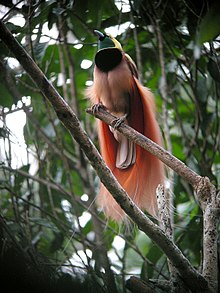Bird-of-paradise
| Bird-of-paradise | |
|---|---|
 | |
| Raggiana bird-of-paradise (Paradisaea raggiana) | |
| Scientific classification | |
| Kingdom: | Animalia |
| Phylum: | Chordata |
| Class: | Aves |
| Order: | Passeriformes |
| Superfamily: | Corvoidea |
| Family: | Paradisaeidae Vigors, 1825 |
| Genera | |
15 genera, 42 species | |
The birds-of-paradise are members of the family Paradisaeidae of the order Passeriformes. The majority of species are found in Papua New Guinea and eastern Australia. The family has 42 species in 15 genera.[1] The members of this family are perhaps best known for the plumage of the males of the species (the majority) which are sexually dimorphic, in particular the very long elaborate feathers extending from the beak, wings, tail or head. For the most part they are confined to dense rainforest habitat. The diet of all species is dominated by fruit and to a lesser extent arthropods. The birds-of-paradise have a variety of breeding systems, ranging from monogamy to lek-type[2] polygamy.
Back to Black: How Birds-of-Paradise Get Their Midnight Feathers
The team's findings reveal a new type of feather microstructure, according to evolutionary biologist Matthew Shawkey of Ghent University in Belgium, who was not involved in the study. “This structure enhances the blackness produced by the feathers' pigments,” Shawkey says.
Black feathers found on other birds-of-paradise—and some found elsewhere on one of the species the team analyzed—reflect between 10 and 100 times more light than the superblack feathers do, McCoy says.
She and her colleagues propose that the inky feathers evolved as a way to emphasize brighter-colored ones, helping to attract potential mates. In all the superblack species the researchers examined, the special feathers were always immediately adjacent to bright, lustrous ones. During mating displays the males hold these plumes so that the feathers appear their darkest from the females' point of view, McCoy notes.
“This is definitely not about camouflage,” Shawkey says. “This superblack plumage is enhancing the contrast with those bright-colored feathers nearby.”







No comments:
Post a Comment